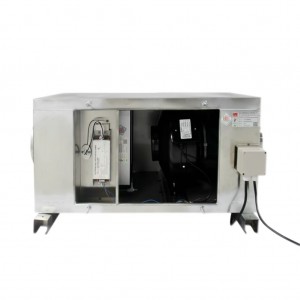I.The requirements of the food and beverage industry for air quality
Food and beverage production has strict requirements for air quality, and odors, volatile organic compounds (VOCs), microorganisms, and dust in the air may affect product quality, flavor, and even food safety. Therefore, chemical air filters play a crucial role in the industry’s multi ring process, ensuring that the production environment complies with standards such as GMP (Good Manufacturing Practice), HACCP (Hazard Analysis and Critical Control Points), and ISO 22000 (Food Safety Management System).
II.The main function of chemical air filters
Chemical air filters (such as activated carbon filters, chemical adsorption filters, photocatalytic oxidation equipment, etc.) are mainly used to remove odors and harmful gases (such as hydrogen sulfide, ammonia, formaldehyde), adsorb volatile organic compounds (VOCs), avoid contaminating food, inhibit microbial growth (some filter materials contain antibacterial coatings), protect employee health, and reduce inhalation of irritating gases.
III. Key application links of chemical air filters in food and beverage production
1. Raw material storage and pretreatment
Applied to warehouses for raw materials such as grains, spices, dairy products, and storage areas for oils or fermentation materials (such as soybeans and yeast). Absorb the odors emitted by volatile raw materials (such as ammonia and sulfides) to prevent cross contamination and ensure the freshness of the raw materials.
2. Fermentation and brewing process
Applied to fermentation workshops such as beer, wine, soy sauce, yogurt, etc. Alcohol distillation or seasoning (such as vinegar) production area. Remove impurities from hydrogen sulfide (H ₂ S) and carbon dioxide (CO ₂) produced during fermentation to avoid odor affecting product flavor.
3. Food processing and cooking
It is used in high temperature processing areas such as frying, baking and smoking, and in seasoning (such as essence and spice) mixing workshops. Filter oil fumes, burnt odors, and chemical volatiles (such as acrolein) to keep the workshop air fresh and avoid cross contamination.
4. Packaging and filling process
Applied to beverage filling lines, dairy product packaging areas, near packaging equipment that uses ink or adhesives. Adsorb VOCs such as benzene and formaldehyde released by solvent based inks to prevent chemical pollutants from adhering to the packaging surface.
5. Wastewater treatment and exhaust emissions
Applied to wastewater treatment stations and exhaust gas discharge outlets in food factories. Removing odorous gases such as hydrogen sulfide and ammonia, in compliance with the “Emission Standards for Odor Pollutants” (GB 14554), and equipped with HEPA filters to simultaneously intercept particulate matter.
6. Laboratory and Quality Inspection Area
It is used in food testing laboratories and essence research and development rooms. Filter volatile gases from chemical reagents (such as ethanol and acetone) to protect precision instruments (such as gas chromatographs) from interference.
IV.Common types of chemical air filters used in the food industry
| Filter Type | Target Pollutant | Applicable Scenarios | Precautions |
| Activated carbon filters | Odor, VOCs (such as benzene derivatives), sulfides | sulfide raw material warehouses, fermentation workshops, and oil processing areas (which may release pollutants after saturation) | Humidity affects adsorption efficiency |
| Chemical adsorption filter cartridge | Formaldehyde (such as KMnO ₄ oxidation), acidic gases (H ₂ S, SO ₂) | packaging areas (ink evaporation), and wastewater treatment stations are prone to failure for high concentration pollutants | Need to monitor the color change status of the filter element |
| Photocatalytic oxidation (PCO) | VOCs (low concentration), microorganisms,formaldehyde | high cleanliness areas for formaldehyde (such as dairy/beverage filling), laboratory needs to cooperate with UV light sources | May generate ozone (choose ozone free catalyst) |
| Electrostatic precipitator+chemical filtration | particulate matter (PM2.5-10)+acidic gas/odor | Regular cleaning of electrostatic modules is required in frying areas, barbecue workshops, and powder raw material processing areas | The chemical filter element needs to be matched with the target gas |
V.FAF products meet industry standards and selection recommendations
1. International standards
ISO 14644-1 (Cleanroom Air Cleanliness Classification).
FDA CFR 21 (Safety Requirements for Food Contact Materials).
2.Key selection points
Humidity adaptability: Due to high humidity in food factories, hydrophobic activated carbon should be selected.
Replacement cycle: Activated carbon filter cartridges are generally replaced every 3-6 months (depending on the concentration of pollutants).
Compliance: Choose food grade materials (such as stainless steel casing, non secondary pollution filter material).
Chemical air filters play the role of “air purification guardians” in the food and beverage industry, ensuring air quality from raw material storage to finished product packaging, guaranteeing product safety, stable flavor, and helping enterprises comply with environmental regulations. In the future, with the development of intelligent monitoring and efficient composite filter materials, chemical filtration technology will play a greater role in the food industry.
Post time: Apr-17-2025


